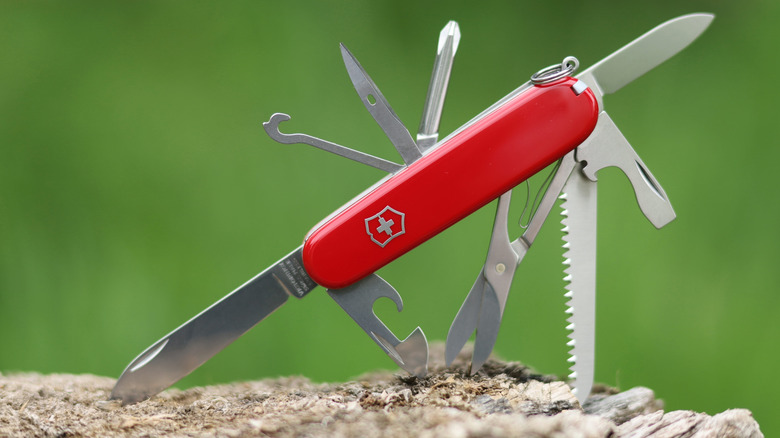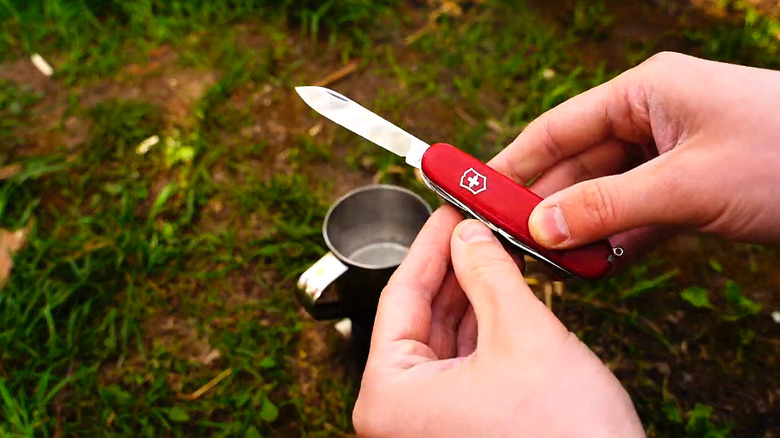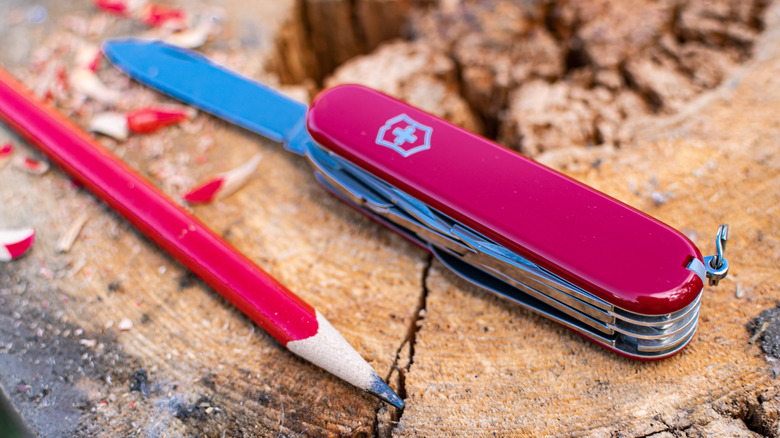Why It's Useful To Have Two Blades On A Swiss Army Knife
Of all the tools and attachments on your Swiss Army knife, the blade may be the most perplexing addition. Maybe not the blade itself necessarily, but why there are two of them. Chances are your swiss army knife has a long blade at one end and a shorter one at the other. While having two may seem a bit redundant at first, there's good reason for the existence of both blades.
The primary benefit of having two blades is that it extends the lifespan of tool itself. While Swiss Army knives are made to take a good bit of abuse and have a diverse array of uses, they, like every tool, will eventually wear out. This is most certainly the case for the blade, which will naturally lose its sharpness overtime. While every aspect of your knife has its purpose, the blade is arguably the most important element, so it makes sense to have two as a way to preserve its functionality. Many users will employ the longer blade as their primary tool and bust out the secondary smaller blade when the other one is worn out. This not only allows for a greater level of conveinence, but also adds to the economical aspect of your Swiss Army knife, as instead of having to buy a new one when your blade goes dull, you can simply switch to the other blade.
However, this only scratches the surface of what each of these blades is capable of. Longtime Swiss Army knife users have proven that each side possesses its own range of versatile functions worth diving into.
The larger blade is well-suited for heavy-duty tasks
It's conceivable to use your longer Swiss Army knife blade as an everyday tool and save the smaller one for backup purposes. However, by taking advantage of the special capabilities that each side offers, you can avoid wearing out either blade too soon while completing tasks with greater efficiency.
As you can imagine, the longer blades are typically best-suited for more intense functions. This includes the ability to cut, score, and slice through tough material such as aluminum, metals, and hard plastics. It's particularly adept at handling wood, with many using it to cut branches and twigs or even split thin logs. If performing the latter, be sure to have your blade be positioned in a 90 degree angle and have something to tap it into the wood to avoid wearing out the spring.
Given its length, this side of the Swiss Army knife is also great because it offers plenty of stability and control. In particular, it has surprisingly versatile uses in the kitchen. Tasks such as cutting meat, shredding vegetables, and slicing fruit can be done efficiently and safely with the long blade for occasions when you don't have a kitchen knife around. Just be sure you're keeping it thoroughly sanitized before and after using it in such an environment.
The smaller blade possesses its own set of specialities
With the size, power, and control offered by the longer blade on your Swiss Army Knife, it may seem baffling to even include a smaller blade to begin with. In truth, the small blade proves to be far more than just a backup tool. The short, blunt build of these handy attachments makes them easier to maneuver about in tighter spaces and safer to use, making them adept at a number of tasks that even larger blades may struggle with.
The small blade is great for handling jobs that require a more delicate approach. This makes them perfect for artists, hobbyists, and craftspeople who can use the blade for tasks such as whittling wood, sharpening pencils, or scoring objects. Some have even found use out of them as a compass to help create perfect circles given their closer proximity to the ground when extended, allowing for better stability. Simply place the blade in the center of where your circle will be and use the pen or corkscrew tool to go around and outline the circle.
Its size also makes this ideal for tasks that would otherwise be too risky for a longer blade to pull off. If you need something to remove a splinter or cut fingernails in a pinch, the small blade can get the job done in an efficient and safe manner. It has proven especially useful in a variety of package opening situations, such as cutting open boxes or undoing zip ties, as its compact size lessens the chances of damage to both you and the contents of your package.


